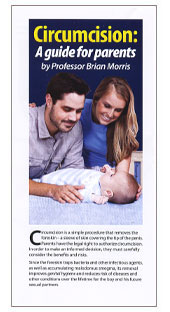Trichomonas in Women
Results from a randomized controlled trial in Uganda, showed reduced Trichomonas vaginalis (adjusted prevalence risk ratio [adjPRR] 0.52), bacterial vaginosis (adjPRR 0.60) and severe bacterial vaginosis (prevalence RR 0.39), as well as genital ulceration (adjusted PRR 0.78) in women whose male partner was in the circumcised arm of the trial [Gray et al., 2009a]. Thus the risk of Trichomonas vaginalis was 48% lower in the wives of the men who were in the circumcised arm of the trial. It was suggested that the moist nature of the subpreputial space might enhance the survival of Trichomonas.
In suburban Sydney, Australia, 3.4% of women were found to be infected with Trichomonas [McIver et al., 2009]. Other microorganisms and their prevalence (in brackets) in cervical swabs in this study were: cytomegalovirus (6.0%), enterovirus (2.1%), Epstein-Barr virus (2.6%), varicella-zoster virus (0.4%), herpes simplex virus type 1 (2.6%), and herpes simplex virus type 2 (0.8%), HSV-2 + VZV (0.4%), Ureaplasma parvum (57%), Ureaplasma urealyticum (6.1%), Mycoplasma genitalium (1.3%), and Mycoplasma hominis (13.7%), Chlamydia trachomatis (0.4%) Trichomonas vaginalis (3.4%), and group B streptococci (0.4%).
For more see systematic reviews [Grund et al., 2017; Morris et al., 2019b].



